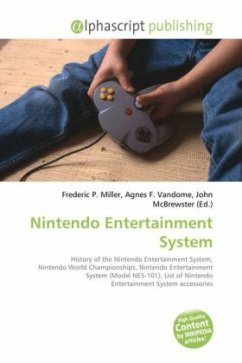
Nintendo Entertainment System
Versandkostenfrei!
Versandfertig in 6-10 Tagen
30,99 €
inkl. MwSt.

PAYBACK Punkte
15 °P sammeln!
Please note that the content of this book primarily consists of articles available from Wikipedia or other free sources online. Following a series of arcade game successes in the early 1980s, Nintendo made plans to produce a cartridge-based console. Masayuki Uemura designed the system, which was released in Japan on July 15, 1983 for Yen 14,800 alongside three ports of Nintendo''s successful arcade games Donkey Kong, Donkey Kong Jr. and Popeye. The Family Computer (or Famicom) was slow to gather momentum; a bad chip set caused the initial release of the system to crash. Following a product rec...
Please note that the content of this book primarily consists of articles available from Wikipedia or other free sources online. Following a series of arcade game successes in the early 1980s, Nintendo made plans to produce a cartridge-based console. Masayuki Uemura designed the system, which was released in Japan on July 15, 1983 for Yen 14,800 alongside three ports of Nintendo''s successful arcade games Donkey Kong, Donkey Kong Jr. and Popeye. The Family Computer (or Famicom) was slow to gather momentum; a bad chip set caused the initial release of the system to crash. Following a product recall and a reissue with a new motherboard, the Famicom''s popularity soared, becoming the best-selling game console in Japan by the end of 1984. Encouraged by these successes, Nintendo soon turned its attention to the North American market. Nintendo entered into negotiations with Atari to release the Famicom under Atari''s name as the name Nintendo Advanced Video Gaming System; however, thisdeal eventually fell apart. Subsequent plans to market a Famicom console in North America featuring a keyboard, cassette data recorder, wireless joystick controller and a special BASIC cartridge under the name "Nintendo Advanced Video System" likewise never materialized.













